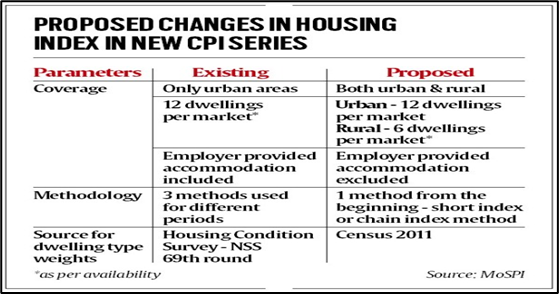Why in News?
- The Ministry of Statistics and Programme Implementation (MoSPI) has proposed key methodological reforms in the Consumer Price Index (CPI), specifically in the compilation of the housing index.
- These reforms aim to make inflation measurement more accurate, representative, and transparent, reflecting post-pandemic changes in rental markets and including rural housing data for the first time.
What’s in Today’s Article?
- Background - CPI and Housing Index
- Proposed Methodological Changes
- Inclusion of Rural Sector through HCES 2023-24
- Transparency and Consultation Process
- Way Forward
- Conclusion
Background - CPI and Housing Index:
- The Consumer Price Index (CPI) is India’s main measure of retail inflation.
- The MoSPI is revising the CPI base year to 2024 from 2012, with item weights based on the 2023-24 Household Consumption Expenditure Survey (HCES).
- Currently, housing data is collected biannually and only for urban areas.
- The weight of housing in the CPI basket is 21.67% for urban areas and 10.07% at the all-India level.
- According to data released last month, housing inflation accelerated to 3.98% in September from 3.09% in August. Overall, India's retail inflation eased to 1.5% from 2.1% over the same period.
- Economists have long criticized the inclusion of employer-provided dwellings and use of House Rent Allowance (HRA) as a rent proxy.
Proposed Methodological Changes:

- Monthly rent data collection:
- Rent data will be collected monthly instead of every six months.
- Coverage expanded to both rural and urban areas, marking a major shift.
- The dwelling type weight will be based on Census 2011.
- Exclusion of employer-provided housing: Government and employer-provided accommodations will be excluded to avoid distortions since they don’t reflect market transactions.
- Expanded sample and IMF guidance:
- Rent data to be collected from all selected dwellings every month (earlier one-sixth sample).
- International Monetary Fund (IMF) technical experts recommended refining India’s panel approach to improve representativeness.
- The revised formula ensures “like-for-like” comparison and avoids downward bias in rent index computation.
Inclusion of Rural Sector through HCES 2023-24:
- The HCES 2023-24 has, for the first time, captured rural house rent and imputed rent for owner-occupied dwellings.
- This enables compilation of a rural housing index, absent in the HCES 2011-12 series.
- The new series will therefore represent comprehensive national housing dynamics.
Transparency and Consultation Process:
- MoSPI released the third discussion paper as part of its base revision exercise of the CPI. Previous papers focused on ‘Treatment of Free Public Distribution System (PDS) Items in CPI Compilation’.
- The Ministry plans to hold data conferences and stakeholder consultations to enhance transparency and inclusiveness.
- Feedback on the housing index changes has been invited till November 20, 2025.
Way Forward:
- The proposed CPI revision will align India’s methodology with global statistical best practices.
- Continuous data collection from rural and urban areas will improve the robustness of inflation measurement.
- Exclusion of non-market housing will enhance accuracy in assessing true inflationary pressures.
- The exercise will also help policy-makers, RBI, and households better understand the impact of housing costs on inflation and real income.
Conclusion:
- The overhaul of the housing index methodology marks a significant reform in India’s CPI framework.
- By integrating monthly, all-India rent data and removing distortionary elements, MoSPI aims to create a more representative and credible inflation index.
- This reform is crucial in the context of post-pandemic rental surges, rural-urban housing disparity, and the need for data-driven economic policymaking in a rapidly evolving economy.









